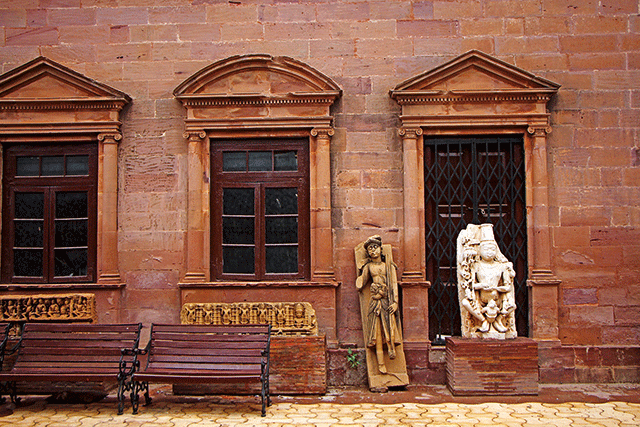
On August 15, 2013, Narendra Modi — then Chief Minister of Gujarat — selected Bhuj as the venue for his Independence Day speech. The city in Kutch was reduced to rubble by the earthquake in January 2001 and later redeveloped under the Modi-led government. As the old-world city of narrow streets, bazaars, ancient palaces and monuments was given a facelift, Bhuj began to enjoy better connectivity through an extensive road network, a new airport, housing development and general improvement in infrastructure.
These changes were viewed positively, especially in light of the business they swept in and the jobs they created. But while political leaders are frequently concerned with matters of commerce and prestige, the day-to-day transformations and repair that Bhuj has seen have come in large parts from active citizens.
Mirroring change
The Aina Mahal or Palace of Mirrors illustrates this spirit admirably. Curator Pramod Jethi has been actively raising funds to reconstruct the museum, which is rapidly returning to its former glory after the earthquake almost destroyed the structure.
Any experience here is replete with people oohing and aahing over a hall > of mirrors, antique pictures, mechanical toys, exquisite china, blue-and-white delft tiles and William Hogarth’s 18th-century lithographs, which reveal the tastes of the former rulers and have been imaginatively contextualised by Jethi.
Outside the Aina Mahal, the characterful but somewhat ramshackle former royal residences with their resplendent latticed windows are now covered in bird droppings. The crumbling ancient structures still tell stories of former magnificence though, and are a metaphor of what the passage of time can do us.
But the architecture is ultimately just a backdrop to the vibrant scope of life, illustrated in the market that lies just beyond these walls.
The bazaar is bright with rickety shops and unabashed energy. Tribal women in open-backed blouses, adorned heavily in silver jewellery and ivory-coloured bangles on their upper arms, wander about, examining the bric-a-brac displayed in various stalls. A fresh fruit and vegetable section housed in a former British garrison dating back to 1833, is rife with the pulse of life so common amid chaos and noise.
A riot of energy
This energy is clearly evidenced in the warm welcome Bollywood megastar and ambassador for Gujarat Tourism, Amitabh Bachchan, receives from an enthusiastic crowd on arrival at Bhuj airport. But you don’t have to be an A-lister or a brand ambassador to enjoy the warm hospitality of its people.
What’s also significant is that this is a society that, despite development, still takes pride in everything local. For instance, Hotel Annapurna undoubtedly does the best vegetarian thali in town. For a few dirhams, feast on curry, chutneys, pickles, dals and kadhi (a blend of yoghurt and gram flour served hot with rice). The waiters keep returning, encouraging you to have more, until you plead for respite.
Another must-visit is the Kutch Museum. Textiles, weapons, silverware and sculpture guide you through Kutch’s history, while legends can be traced in the remarkable motifs embroidered on cloth.
The Sri Swaminarayan Mandir is also well worth a visit. Dating back to 1823, it was also damaged in the earthquake and rebuilt. Visitors get to see the marble and gold structure in all its former glory. Its ornate domes and carvings symbolise more than a place of worship; they also stand for local resilience.
Persevering with tradition
There’s a certain vibrance among the craftsmen of Bhuj. Visit Khamir — one in a range of grass-roots organisations striving to revive and encourage the crafts in these parts — and you’ll see locals persevering with traditions that have been around for generations. Weavers here, block printers there and potters just about everywhere. A variation in an old form of metal bell-making evokes great pleasure, while contemporary design delights buyers looking to lug some classic Gujarati artwork home.
The ingenuity of their work is matched by the dedication of the craftsmen. One tells me he wouldn’t move to a city for more pay or comfortable summers. “I live in a striking landscape — the land of the great salt desert, flamingos, cranes and migratory birds,” he says.
“I live close to nature, to the source of all inspiration. What good can a few more pieces of gold bring me? Heaven is not in seeking paradise, but in finding paradise in what I have.”
Looking at the stark, desolate but utterly striking landscape, what inspires such tenacity in the craftsman is clear. On your way home, you leave Bhuj with a dismissal of the armchair wisdom that the world has become a homogenous place.







